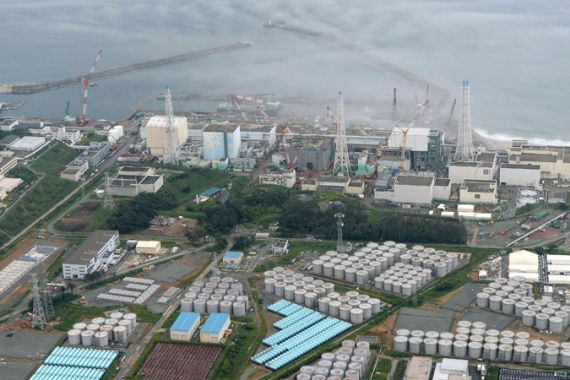Authorities checking Fukushima storage tanks
Workers at stricken Japanese nuclear plant carrying out checks after 300 tonnes of contaminated water leaked into soil.

Workers at Japan’s crippled Fukushima nuclear power plant are scrambling to carry out checks on hundreds of tanks storing highly radioactive water, after one of them leaked about 300,000 litres of contaminated water, authorities say.
The crews of workers were checking tanks on Thursday, after 300 tonnes of toxic liquid escaped from one of the tanks that hold water used to cool the broken reactors.
Keep reading
list of 4 itemsTurtles swimming to extinction in Malaysia as male hatchlings feel heat
Could shipping containers be the answer to Ghana’s housing crisis?
Thousands protest against over-tourism in Spain’s Canary Islands
The Tokyo Electric Power Company (TEPCO), which operates the plant, said that some of the contaminated water may have flowed into the ocean.
“We are hurriedly checking if some 300 tanks of the same type holding contaminated water have the same leak problem,” Tsuyoshi Numajiri, a TEPCO spokesman, said on Wednesday.
“We have finished pumping out water from the troubled tank, while we have continued removing the soil soaked by the water,” he said.
“We cannot rule out the possibility that part of the contaminated water flowed into the sea.” said.
Threat level elevated
On Wednesday, nuclear regulators said the leak represented a level-three “serious incident” on the UN’s seven-point International Nuclear Event Scale (INES), which measures radiation accidents.
The alert was raised from level one, which indicates an “anomaly”. It is the most serious single event since the plant was declared to be in a “state of cold shutdown” – effectively indicating it was under control at the end of 2011.
The quake and tsunami-sparked meltdowns at the plant in March of that year were ultimately categorised as level seven on the INES scale. The Chernobyl disaster in 1986 is the only other incident to have been given the most serious ranking.
TEPCO has said puddles of water near the tank were so toxic that anyone exposed to them would receive the same amount of radiation in an hour that a nuclear plant worker in Japan is allowed to receive in five years.
The absence of a water-level gauge on the 1,000-tonne tank made detecting the problem more difficult, experts say.
Thursday’s safety checks on 300 tanks came after Nuclear Regulation Authority (NRA) chairman Shunichi Tanaka on Wednesday voiced concern that there could be similar leaks from other containers.
“We must carefully deal with the problem on the assumption that if one tank springs a leak the same thing can happen at other tanks,” he said.
There are about 1,000 tanks of varying sizes installed at the site.
Experts say levels of radiation in the ocean in several spots along the Fukushima coast have been recovering in recent days.
“It is too early to estimate the impact of the latest leak,” said Masashi Kusakabe, researcher at Marine Ecology research Institute.
“All we can do is to continue monitoring levels of marine radiation very carefully,” Kusakabe said.
Jota Kanda, an oceanographer and professor at Tokyo University of Marine Science and Technology, said: “It is inevitable that some water has reached the sea. So far its impact on the marine environment is limited, but it will be a different story if more leaks happen.”
While no one is officially recorded as having died as a direct result of the radiation released by the meltdowns, large areas around the plant had to be evacuated.
Tens of thousands of people are still unable to return to their homes, with scientists saying some areas may have to be abandoned.